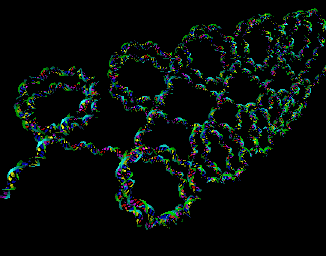UNCOILING THE MYSTERIES OF DNA

|
It is an axiom of biology that function follows form. Nowhere is this more true than in the tangled coils and folds of deoxyribonucleic acid -- DNA -- the molecule that contains the genetic code for life. A molecule of DNA consists of "base pairs" (the letters of the genetic code) that are linked to twin strands of sugars and phosphates which spiral around one another in the familiar double helix. DNA molecules can be astonishingly long. For example, if the DNA in the nucleus of a typical human cell were to be stretched out flat, it would extend about six feet in length. Stuffing so large a molecule into so tiny a space is a near-miraculous feat of engineering, requiring the DNA's sugar-phosphate backbone to be coiled and folded over many thousands of times.
To decipher the genetic code and learn more about how the genetic process works and how damage occurs, scientists need to unravel DNA molecules. DNA is typically wrapped around a mixture of proteins called "histone" that provide the giant molecule with structural support. Repeating segments of DNA, some 165 to 240 base pairs in length, combine with eight histone molecules to form a distinct unit called a "nucleosome." Nucleosomes are in turn organized into even larger units called "chromatin." How the nucleosomes within a single fiber of chromatin are arranged with respect to one another, ie., are they spaced close together or far apart, tells much about their susceptibility to mutation and other problems.
For the past 20 years, the prevailing view has been that the nucleosomes within a chromatin fiber are aligned in a simple helical pattern along the axis of the chromatin, with adjacent nucleosomes positioned as nearest neighbors, to give the fiber a solenoidal or tubular shape. This image was based on data collected from DNA that had been removed from a cell and processed. Berkeley Lab scientists, based on earlier work, directly fragmented DNA with radiation while it was still inside a cell and analyzed the resulting damage. Working with this data, the Visualization Group has confirmed a new and different image of the shape of a chromatin fiber. Adjacent nucleosomes appear to form a zig-zag pattern so that alternate nucleosomes become nearest neighbors. On the average, about half these nucleosomes are positioned parallel and half perpendicular to the axis of the chromatin, which greatly affects the spacing between them.
 PART TWO: THE SWIRLING FORCES OF TURBULENCE
PART TWO: THE SWIRLING FORCES OF TURBULENCE
PART FOUR: CHARACTERIZING COPPER DEPOSITS
